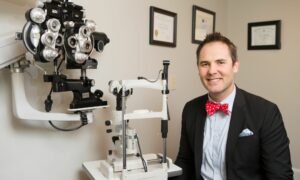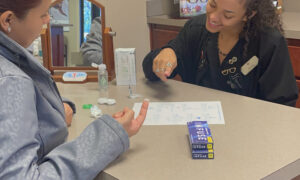By Brian Chou, OD,  FAAO
FAAO
How can two optometrists share the same credentials and practice resources, yet provide completely different patient experiences? This topic has fascinated me for years. After much observation and contemplation, I am convinced that the separating factor is communication skills. These skills include both body language and verbal communication, including careful listening.
In clinical practice, elevating the patient experience has less to do with the doctor’s past laurels and academic grades, but more to do with reacting in-the-moment with sub-communications and micro-expressions such as body posture, gestures, eye contact and voice tonality.
Most of the elements of communication naturally fall into place when the doctor genuinely cares and is interested in the patient. Still, some of these skills are worth mentioning, because our formal training and emphasis in medical optometry may have dulled our ability to effectively communicate. How is this possible? The emphasis on medical eyecare is about sickness and disease. With medical insurance, the practitioner must interact with the exam record sometimes more than the patient, to maximize reimbursement by fulfilling elements of history-taking, obtaining specific measurements and categorizing clinical decision-making. Chair-side manner takes a backseat.
For example, when it comes to elective contact lens wear, provider charm and patient happiness are more important. If deficient, the patient will seek another practice, especially since contact lens services are often an out-of-pocket expense. Mind you, there is no shortage of eyecare providers either.
Clinical experience may have already taught you some of the revelations that I enumerate below. I have found these to facilitate patient success with contact lenses.
Ask happy questions. How often have you or a colleague asked, “Are you having any problems with your contacts?” This cringe-worthy yet commonly uttered question is worse than hearing a clichéd pick-up line in a bar. Sure, this question is functional and fulfills the chief complaint requirement in medical history intake. But for elective contact lens wear, it puts the kibosh on a patient’s good experience. Instead, ask questions like, “How are you enjoying freedom from eyeglasses?” or, “What do your friends and family think of you wearing contacts?” If the patient is having concerns, you’ve got to trust that this information will come out in due course.
Control expectations. There is nothing more damaging to the soft multifocal patient’s psyche than having them start reading the Snellen letters close to their spectacle threshold acuity. Evaluate acuity binocularly first and start with the largest letters! It’s not enough to just make the measurement, but you should also comment on the outcome, especially with adults. Remember that the human tendency is to believe that they are above average–the Lake Wobegon Effect. I don’t see anything wrong in playing that up, particularly if it enhances the patient’s contact lens wearing experience. Although in the medical model, the goal is to get to the threshold line as quickly as possible to allow time to see more patients, with elective contact lens prescribing there should be as much effort to make the patient feel good. When you approach threshold acuity, you can reinforce a patient’s positive experience by prefacing the measurement, saying under your breath, “I don’t expect you to read these letters.” Another key is to under-promise and over-deliver. With multifocal contact lenses or monovision, set the bar prior to beginning the prescribing process.
Use emotional contagion. Patients new to contact lenses are looking to you and your staff for guidance. This is reminiscent of a child who has never had dilating drops instilled before, looking toward his mother’s face to figure out how to react. If the mother’s expressions communicate that the drops will cause pain, the child will freak out. But if her expressions are comforting, calm and reassuring, it’s no big deal to the child. In similar fashion, if you are happy and upbeat about the patient’s clinical outcome, you must expressively communicate this so that it transfers to the patient. If you just spew some technical jargon and dryly tell the patient that you have finalized the contact lens prescription, the patient may leave feeling unsettled from the experience rather than reassured that they made a good decision.
With an understanding of the nuances of charm and mastery of communication, I dare say that you could routinely create a positive patient experience even if you were limited to prescribing polymacon lenses with thermal disinfection. Of course, I am not suggesting that you abandon current contact lens technology. Yet the point remains that the art of optometry can trump the science.
How do you use your communication skills to educate your patients and improve the patient experience? What has and hasn’t worked for you?
Brian Chou, OD, FAAO, is a partner with EyeLux Optometry in San Diego, Calif. To contact him: chou@refractivesource.com.



























